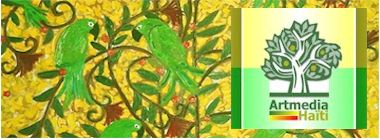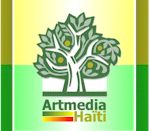
|
|
|
| --> Category: The Arts in Haiti - Caribbean Supersite |
| |
|
|
| Haitian handicraft and naive art is the best in the Caribbean. |
|
Even such utilitarian articles as the woven straw shoulder bags and the tooled-leather scabbards of the peasant machete have great beauty. The rada (Voodoo drum) is an object of great aesthetic appeal. Haiti is famed for its wood carvings, but poverty has pushed craftsmen into producing art from such cheap material as papier maché and steel drums, flattened and turned into cut-out wall-hangings or sculpture. Haitian naive art on canvas emerged only in response to the demand of travellers and tourists in the 1930s and 40s, but it had always existed on the walls of Voodoo temples, where some of the best representations of the spirit world are to be found. Weddings, cock fights, market scenes or fantasy African jungles are other favoured themes. Good paintings can range from one hundred to several thousand dollars. Mass-produced but lively copies of the masters sell for as little as US$10. Negotiating with street vendors and artists can be an animated experience, offering insights into the nation’s personality. Exposure to white racism during the US occupation shook some of the mulatto intellectuals out of their complacent Francophilia. Led by Jean Price Mars and his 1919 pioneering essay Ainsi parla l’oncle (Thus Spoke Uncle) they began to seek their identity in Haiti’s African roots. Peasant life, Créole expressions and Voodoo started to appear together with a Marxist perspective in novels such as Jacques Romain’s Gouverneurs de la rosée (Masters of the Dew). René Depestre, now resident in Paris after years in Cuba, is viewed as Haiti’s greatest living novelist. Voodoo, politics and acerbic social comment are blended in the novels of Gary Victor, a deputy minister in the Aristide government before the coup. The Arts in Haiti by The Caribbean Supersite http://caribbeansupersite.com |
|
|
||
 Designed and Maintained by InterMedia, The Internet Communications Network of Haiti™  ArtMediaHaïti Suite 200 - Angles des Rues Grégoire et Chavannes P.O. Box 16042 - Pétionville, Haiti Telephone: (509) 511-1314, 557-5290, 403-1130, 401-1626 - Fax: (626) 608-3594 http://www.artmediahaiti.com [email protected] |
||
| Service | Contact | Cart-Panier | Home-Accueil | ||
| © All Rights Reserved-Copyright©2001-2002 by ArtMedia Haiti-Port-au-Prince, Haiti | ||
